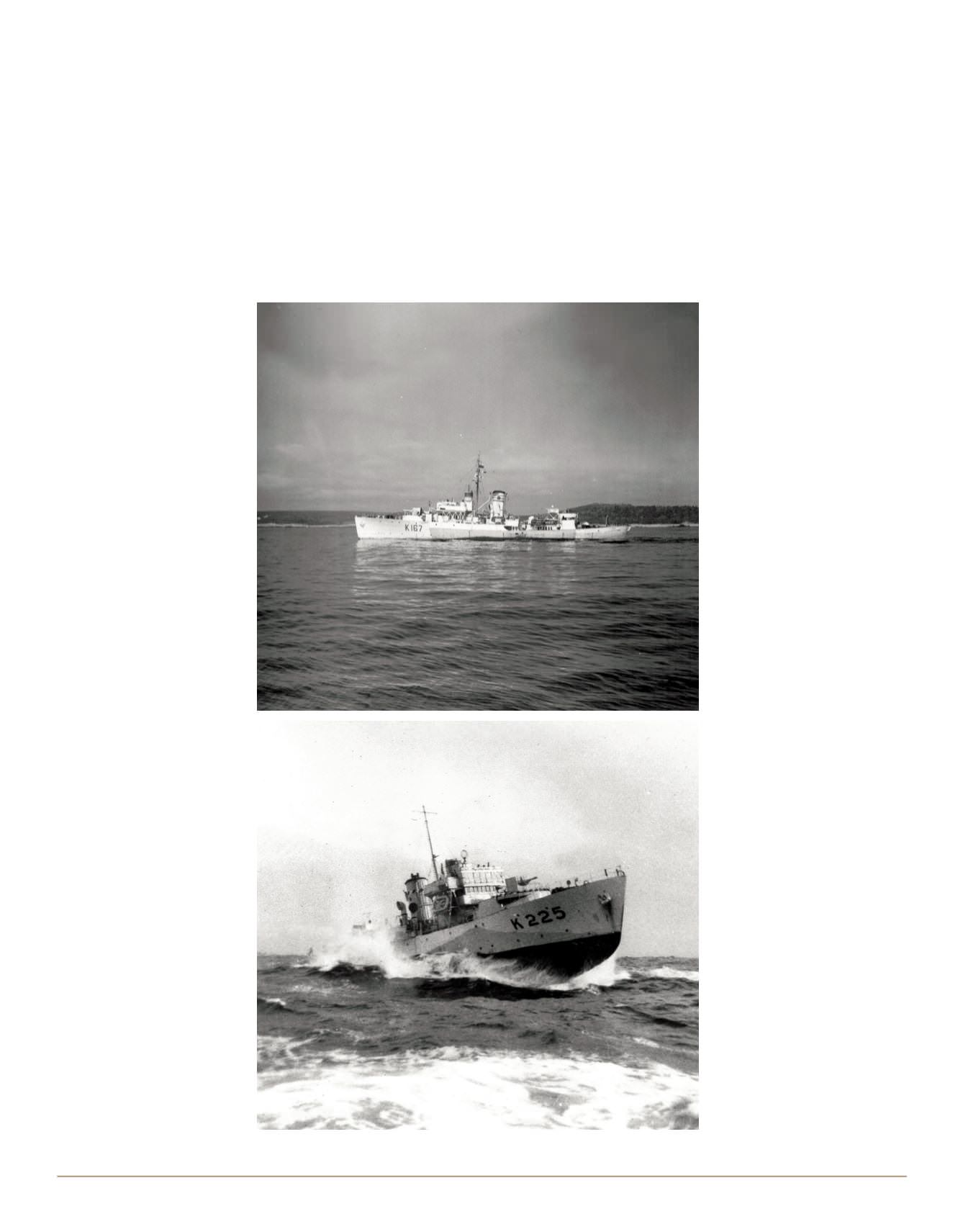
110
|
It was apparent that nomedical officers had
servedonboardanyof the small escort ships
and theadmiralorderedallavailabledoctors
to report for sea- borne manoeuvres. The
medics,whohadnot been to sea for years, if
ever, immediately became seasick and the
railsof thesmallboats theyhadbeenassigned
towere crowdedwithmen. As adirect result
of this activityand the sufferingof StokerMa-
honey, two renownedCanadiandoctors,Pen-
field and Best, developed Pill No. 2-183 to
alleviate theeffectsof seasickness.
JohnRhodesbelieves thatStoker
Mahoney deserved to win a
medal for his inspiration in find-
inga relief for adisease that hit
the sailors of theNorthAtlantic
almost as hardas aU-Boat tor-
pedo.
TheCorvettesof theRoyalCana-
dian Navy that were built in
CollingwoodShipyards served
courageouslyduring theSecond
WorldWar.
HMCSDrumheller, launched5
July1941, was assigned to the
“Newfie—Derry run”and inMay
1943, she teamed up with a
Royal Air ForceSundlerland fly-
ing boat patrol bomber and
HMS Lagan of the Royal Navy
to sink German U-Boat 753.
Drumheller later participated in
the largest armada ever assem-
bledduringwaron6 June1944
thatwas knownasD-Day.
HMCS Moose Jaw was origi-
nally tobenamedafter the town
of Churchill Manitoba but the
Royal Navywon out the battle
ofnamesandassignedChurchill
tooneof their vessels.
Moose Jawdidnot suffer from its
new identity and on 5 May
1941 she sank U-Boat 501 in
theDenmarkStrait southof Tasi-
ilaq,Greenland,usingexplosive
depth charges andby ramming
theenemy submarine.
In April 1944, after serving in
the North Atlantic, HMCS
Woodstock was assigned to
OperationNeptunewhichwas
a naval component of the inva-
sion of Hitler’s European de-
fencesatNormandy, France.
On D-Day, Woodstock supported the US
Army landingsoffOmahaBeach. This treach-
erous landmark that was bordered by two
rocky cliffs proved toby a nightmare for the
US forces. Very littlewent asplannedon that
damp, drizzly, day and many landing craft
ended upoff-target resulting in huge casual-
ties. ThemenaboardWoodstock couldonly
watch from theEnglishChannelas theirAmer-
ican allies facedmurderous fire that held the
invading force to an in-land toehold only a
coupleof kilometresoff thebeach.
Thingsdidnotgoparticularlywell for the skip-
perorHMCSOrillia inMay1941. Lieutenant
CommanderTedBriggs’ shipwasassigned to
slow convoy SC 42 that sailed out of St.
John’s,Newfoundland. The convoywasmet
head-on by a U-Boat Wolfpack of 14 sub-
marines. During the fierce battle, Orillia
droppedback topluck survivors from the icy
water. She also stood by the torpedoed
tankerTahcheeand towed that vesselback to
Iceland. Although the commander hadper-
formed a valiant action undoubtedly saving
the lives of many merchant sea-
men,hehad failed to informhissu-
periors of the gesture and the
convoy’sprotectiveescortwas re-
duced by his one ship. This
caused chaos within SC-42 and
as a result, 16 ships were sunk
during thebattle.
Lifeaboard corvettes likeHMCS
Collingwoodwasdifficult. The85
officersandmenaboard theships
werealmost constantlydampand
cold.Officialnavyphotographer,
LtGilbert A.Milne spent muchof
the war taking photographs of
sailorsand their ships. Inhisbook
“HMCS” he describes the sleek,
fast destroyers as the “Glamour
girlsof thenavy.” Of thecorvettes
he said, “But ofall theRCN ships,
the corvette was the symbol of
Canada’s war at sea. She was
dumpy, she rolled outrageously
andsheseemed tospendasmuch
timeunder thewavesason topof
them. But shewas thebackbone
of theNorthAtlantic convoy sys-
tem.”
Although HMCS Collingwood,
and the other ships built in the
Town’s shipyards ended their
service ingloriously by the sav-
agery of the cutter’s torch, their
memoriesand stories liveonasa
triumph of Canada’s and the
Town of Collingwood’s contribu-
tion to the vital effort that culmi-
nated on 7 May 1945, with
Victory inEuropeDay.
|E|
HMCSDrumheller, launched5July1941
HMCSKitchener inheavyseas
Butof all theRCNships, thecorvettewas thesymbol
ofCanada’swarat sea. Shewasdumpy, she rolled
outrageouslyandsheseemed tospendasmuch time
under thewavesason topof them. But shewas the
backboneof theNorthAtlanticconvoysystem.
~ Lt Gilbert A.Milne
COMMUNITY
|
HISTORY


